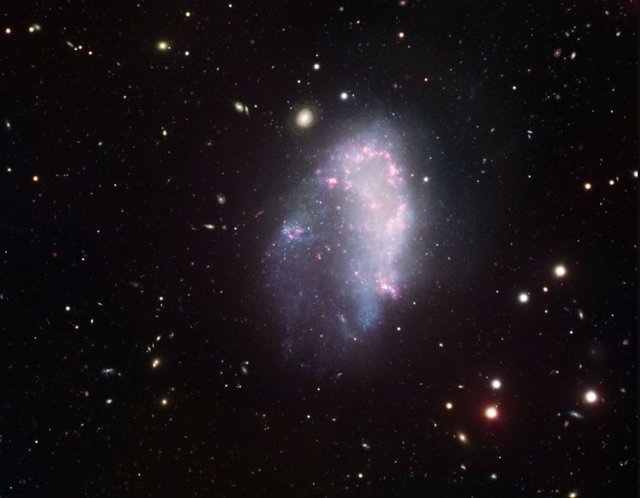The dwarf galaxy NGC1427A flies through the Fornax cluster of galaxies and undergoes perturbations that would not be possible if this galaxy were surrounded by an extensive and heavy halo of dark matter, as required by standard cosmology. – IT’S
Aug. 5 () –
Observations of Fornax, the second closest cluster of galaxies to Earth, do not record a trace of a possible halo of dark matter particles, challenging the standard model of cosmology.
According to the standard model of cosmology, the vast majority of galaxies are surrounded by a halo of dark matter particles. This halo is invisible, but its mass exerts a strong gravitational pull on nearby galaxies.
A new study has been published in the journal Monthly Notices of the Royal Astronomical Society by a team led by the University of Bonn (Germany) and the University of Saint Andrews (Scotland).
Dwarf galaxies are small, faint galaxies that can usually be found in galaxy clusters or near larger galaxies. Because of this, they could be affected by the gravitational effects of their larger companions.
“We present an innovative way to test the Standard Model based on the number of dwarf galaxies that are perturbed by gravitational ‘tides’ from nearby larger galaxies,” he said. it’s a statement Elena Asencio, doctoral student at the University of Bonn and lead author of the paper. Tides arise when the gravity of one body pulls differently on different parts of another body. They are similar to tides on Earth, which arise because the Moon pulls harder on the side of Earth that faces the Moon.
The Fornax cluster has a rich population of dwarf galaxies. Recent observations show that some of these dwarfs appear distorted, as if they have been disturbed by the cluster’s environment. “Such perturbations in Fornax dwarfs are not expected according to the Standard Model.said Pavel Kroupa, a professor at the University of Bonn and Karlova University in Prague. “.

The authors analyzed the expected level of perturbation of the dwarfs, which depends on their internal properties and their distance from the center of the gravitationally powerful cluster. Galaxies with large sizes but low stellar masses and galaxies near the center of the cluster are more easily disturbed or destroyed. They compared the results with their observed level of disturbance evident from photographs taken by the European Southern Observatory’s VLT Survey Telescope.
Elena Asencio says that “the comparison showed that, if you want to explain the observations in the standard model, the Fornax dwarfs should already be destroyed by gravity from the center of the cluster even when the tides it kicks up on a dwarf are sixty-four times weaker than the dwarf’s own gravity.” This is not only counterintuitive, he said, but also contradicts previous studies, which found that the external force needed to perturb a dwarf galaxy is about the same as the dwarf’s own gravity.
From this, the authors concluded that, in the standard model, it is not possible to explain the observed morphologies of Fornax dwarfs in a self-consistent way. They repeated the analysis using milgromian dynamics (MOND). Instead of assuming halos of dark matter surrounding galaxies, the MOND theory proposes a correction of Newtonian dynamics. by which gravity experiences an impulse in the regime of low accelerations.
“We were not sure that dwarf galaxies could survive in the extreme environment of a galaxy cluster in MOND, due to the absence of protective halos of dark matter in this model,” said Dr Indranil Banik from the University of St Andrews. “But our results show a remarkable agreement between the MOND observations and expectations for the level of disturbance of the Fornax dwarfs.”




![[Img #74661]](https://thelatestnews.world/wp-content/uploads/2024/12/The-power-of-ultrasound-150x150.jpg)








![[Img #74661]](https://thelatestnews.world/wp-content/uploads/2024/12/The-power-of-ultrasound-300x200.jpg)


Add Comment